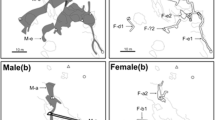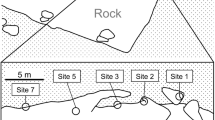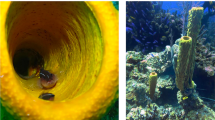Synopsis
Obligate coral-dwelling hawkfishes have been hypothesized to be monogamous. This hypothesized mating system is at odds with what is known of those of other cirrhitids. Neocirrhites armatus, which inhabits Pocillopora spp. corals, and Oxycirrhites typus, which inhabits gorgonians and antipatharian corals, were examined for evidence of a monogamous mating system. Life history criteria that favor monogamy in reef fishes (Barlow 1986) were examined for these two species. Facultative monogamy was found in both. In this mating system, males are limited in their ability to acquire and maintain females, and thus have only a single mate, but may acquire additional females if conditions for doing so are favorable.
Similar content being viewed by others
References cited
Barlow, G.W. 1981. Patterns of parental investment, dispersal and size among coral-reef fishes. Env. Biol. Fish. 6: 65–85.
Barlow, G.W. 1984. Patterns of monogamy among teleost fishes. Arch. FischWiss., Beih. 1: 75–123.
Barlow, G.W. 1986. A comparison of monogamy among freshwater and coral-reef fishes. pp. 767–775. In: T. Uyeno, R. Arai, T. Taniuchi & K. Matsuura (ed.) Indo-Pacific Fish Biology: Proceeding of the Second International Conference of Indo-Pacific Fishes, Ichthyological Society of Japan, Tokyo.
Barlow, G.W. 1988. Monogamy in relation to resources. pp. 55–79. In: C.N. Slobodchikoff (ed.) The Ecology of Social Behavior, Academic Press, New York.
Burgess, W.E. 1978. Butterflyfishes of the world. T.F.H. Publications, Neptune City. 832 pp.
Carlson, B.A. 1975. A scarlet hawkfish from the Fiji islands. Trop. Fish. Hobbyist 23 (8): 36–40.
Doherty, P.J., D. McB. Williams & P.F. Sale. 1985. The adaptive significance of larval dispersal in coral reef fishes. Env. Biol. Fish. 12: 81–90.
Donaldson, T.J. 1986a. Distribution and species richness patterns of Indo-West Pacific Cirrhitidae: support for Woodland's hypothesis. pp. 623–628. In: T. Uyeno, R. Arai, T. Taniuchi & K. Matsuura (ed.) Indo-Pacific Fish Biology: Proceedings of the Second International Conference on IndoPacific Fishes, Ichthyological Society of Japan, Tokyo.
Donaldson, T.J. 1986b. Courtship and spawning of the hawkfish Cirrhitichthys falco at Miyake-jima, Japan. Jap. J. Ichthyol. 33: 329–333.
Donaldson, T.J. 1987. Social organization and reproductive behavior of the hawkfish Cirrhitichthys falco (Cirrhitidae). Bull. Mar. Sci. 41: 531–540.
Donaldson, T.J. 1989. Pair spawning of the grouper Cephalopholis boenack at Papua New Guinea. Jap. J. Ichthyol. (in press).
Donaldson, T.J. & P.L. Colin. 1989. Pelagic spawning of the hawkfish Oxycirrhites typus (Cirrhitidae). Env. Biol. Fish. 24: 295–300.
Driscoll, J.W. & J.L. Driscoll. 1988. Pair behavior and spacing in butterflyfishes (Chaetodontidae). Env. Biol. Fish. 22: 29–37.
Fricke, H.-W. 1973. Behavior as a part of ecological adaptation. Helgol. wiss. Meeresunters. 24: 120–144.
Fricke, H.-W. 1974. Öko-Ethologie des monogamen Anemonenfisches Amphiprion bicinctus. Z. Tierpsychol. 36: 429–513.
Fricke, H.-W. & S.F. Fricke. 1977. Monogamy and sex change by aggressive dominance in coral reef fish. Nature (Lond.) 266: 830–832.
Ghiselin, M.T. 1969. The evolution of hermaphroditism among animals. Q. Rev. Biol. 44: 189–208.
Gronell, A.M. 1984. Courtship, spawning and social organization of the pipefish, Corythoichthys intestinalis (Pisces: Syngnathidae) with notes on two congeneric species. Z. Tierpsychol. 65: 1–24.
Johannes, R.E. 1978. Reproductive strategies of coastal marine fishes in the tropics. Env. Biol. Fish. 3: 65–84.
Kobayashi, K., K. Suzuki, T. Suzuki & S. Mishina.1985. Hermaphroditism in the four Japanese cirrhitid fishes. Advance Abstracts for the 18th Annual Meeting of the Ichthyological Society of Japan, No. 38 (in Japanese).
Kuwamura, T. 1985. Social and reproductive behavior of three mouthbrooding cardinalfishes, Apogon doederleini, A. niger and A. notatus. Env. Biol. Fish. 13: 17–24.
Lassig, B. 1976. Field observations on the reproductive behavior of Paragobiodon spp. (Osteichthyes: Gobiidae) at Heron Island, Great Barrier Reef. Mar. Behav. Physiol. 3: 283–293.
Lobel, P.S. 1974. Sea-spawnings hawkfish. Octopus 1 (7): 23.
Lubbock, R. 1978. A new hawkfish of the genus Amblycirrhitus Gill 1862, from Ascension Island South Atlantic. Senckenbergiana Biol. 58: 261–265.
Masuda, H., K. Amaoka, C. Araga, T. Uyeno & T. Yoshino (ed.). 1985. The fishes of the Japanese Archipelago. Tokai University Press, Tokyo, 2 vols., 437 pp., 370 pls.
Moyer, J.T. & L.J. Bell. 1976. Reproductive behavior of the anemonefish Amphiprion clarkii at Miyake-jima, Japan. Jap. J. Ichthyol. 23: 23–32.
Moyer, J.T. & M. Zaiser. 1984. Early sex change: a possible mating strategy of Centropyge angelfishes (Pisces: Pomacanthidae). J. Ethol. 2: 63–67.
Myers, R.F. & J.W. Shepard. 1981. New records of fishes from Guam, with notes on the ichthyofauna of the southern Marianas. Micronesica 16: 305–347.
Randall, J.E. 1963. Review of the hawkfishes (Family Cirrhitidae). Proc. U.S. Nat. Mus. 114 (3472): 389–451.
Randall, J.E. 1985. Guide to Hawaiian reef fishes. Harrowood Books, Newton Square. 79 pp.
Reese, E.S. 1975. A comparative field study of the social behavior and related ecology of reef fishes of the family Chaetodontidae. Z. Tierpsychol. 37: 37–61.
Robertson, D.R., N.V.C. Polunin & K. Leighton. 1979. The behavioral ecology of three Indian Ocean surgeonfishes (Acanthurus lineatus, A. leucosternon and Zebrasoma scopas): their feeding strategies and social and mating systems. Env. Biol. Fish. 4: 125–170.
Shapiro, D.Y, D.A. Hensley & R.S. Appeldoorn. 1988. Pelagic spawning and egg transport in coral-reef fishes: a skeptical overview. Env. Biol. Fish. 22: 3–14.
Springer, V.G. 1982. Pacific Plate biiogeography, with special reference to shorefishes. Smithson, Contrib. Zool. 367. 182 pp.
Thomson, D.A., L.T. Findley & A.N. Kerstich. 1987. Reef fishes of the Sea of Cortez, 2nd ed. University of Arizona Press, Tucson. 302 pp.
Thresher, .E. 1984. Reproduction in reef fishes. T.F.H. Publ., Neptune City. 399 pp.
Thresher, R.E. 1988. Latitudinal variation in egg sizes of tropical and sub-tropical North Atlantic shore fishes. Env. Biol. Fish. 21: 17–25.
Tricas, T.C. 1985. The economics of territoriality in coral-feeding butterflyfishes of Hawaii. Proc. 5th Int. Coral Reef Congr. 5: 409–414.
Wilson, E.O. 1975. Sociobiology. Belknap Press of Harvard University Press, Cambridge. 697 pp
Author information
Authors and Affiliations
Rights and permissions
About this article
Cite this article
Donaldson, T.J. Facultative monogamy in obligate coral-dwelling hawkfishes (Cirrh tidae). Environ Biol Fish 26, 295–302 (1989). https://doi.org/10.1007/BF00002466
Received:
Accepted:
Issue Date:
DOI: https://doi.org/10.1007/BF00002466




